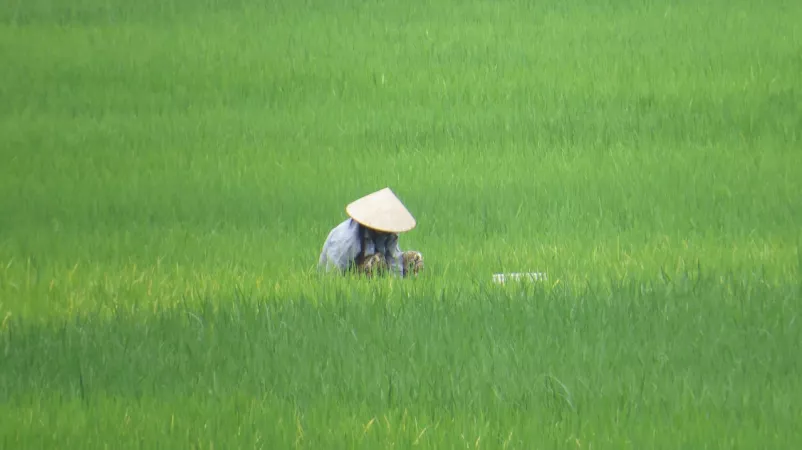
Ca Mau Travel Guide
Ca Mau, located in the southernmost part of Vietnam, is a province known for its rich history, diverse geography, and vibrant culture. This coastal destination is famous for its unique mangrove forests, bustling floating markets, and traditional fishing villages. Ca Mau is also renowned for being the location where the Mekong River meets the South China Sea, making it a significant ecological hotspot in the region.Top Attractions in Ca Mau
1. Hon Khoai Island 2. U Minh Ha National Park 3. Ca Mau Cape 4. Tan Thuan Floating Market 5. Ngoc Hien Bird GardenCa Mau is Famous for
Its pristine mangrove forests and unique ecosystem.Top Attractions in Ca Mau
- Hon Khoai Island - U Minh Ha National Park - Ca Mau Cape - Tan Thuan Floating Market - Ngoc Hien Bird GardenWhat's Great about Travelling to Ca Mau?
- Rich cultural experiences - Stunning natural landscapes - Authentic local cuisineWhat's Not So Great about Travelling to Ca Mau?
- Limited public transportation options - Hot and humid climate - Language barrier for non-Vietnamese speakersTravel Tips for Ca Mau
- Carry insect repellent for mangrove areas - Respect local customs and traditions - Use reputable tour operators for excursionsImportant Ca Mau trip information
- Ideal Duration: A week to explore the main attractions.
- Best Time to Visit: December to April for dry weather.
- Nearby Airports and Railway Stations: Ca Mau Airport and Ca Mau Railway Station.
FAQ's on Ca Mau
Q1: What is the best time to visit Ca Mau?
The best time to visit Ca Mau is during the dry season from December to April when the weather is pleasant and ideal for exploring the region. However, if you want to witness the bustling local life and festivals, consider visiting during the rainy season from May to November. Just be prepared for occasional downpours.
Q2: Do I need a visa to travel to Ca Mau?
Most visitors to Ca Mau will need a visa to enter the country. However, some nationalities may be exempt or eligible for visa on arrival. It is recommended to check with the nearest consulate or embassy for the most up-to-date visa requirements before your trip.
Q3: What are the must-visit attractions in Ca Mau?
Ca Mau is known for its unique attractions, including the Ca Mau Cape National Park, Tan Thuan Floating Market, and Nguyen Tien Khang Street. Don't miss the chance to explore the mangrove forests, bird sanctuaries, and local markets for an authentic experience.
Q4: Is Ca Mau a safe place to travel?
Ca Mau is generally a safe place to travel, but like any destination, it is advisable to stay cautious and be aware of your surroundings. Avoid isolated areas at night and take necessary precautions to safeguard your belongings.
Q5: What is the local currency in Ca Mau and can I use credit cards?
The local currency in Ca Mau is the Vietnamese Dong. While credit cards are accepted in major hotels and restaurants, it is recommended to carry cash for smaller establishments and markets. ATMs are also readily available in urban areas.
Q6: What is the local cuisine like in Ca Mau?
Ca Mau offers a diverse culinary scene with fresh seafood being a highlight. Try local specialties like banh xeo (sizzling pancakes), ca loc hap bia (steamed fish with beer), and banh khot (mini savory pancakes). Vegetarian options are also available for those with dietary restrictions.
Q7: What transportation options are available in Ca Mau?
Transportation options in Ca Mau include buses, taxis, motorbike rentals, and cycle rickshaws. Public transport is affordable and convenient for getting around the city, while taxis are a good option for longer distances or late-night travels.
Q8: Are there any cultural norms or etiquette I should be aware of when visiting Ca Mau?
When visiting Ca Mau, it is important to respect local customs such as removing shoes before entering homes or temples, dressing modestly when visiting religious sites, and greeting people with a handshake or slight bow. Avoid public displays of affection and always ask for permission before taking someone's photo.
Q9: I am a travel agent. How can I buy travel leads of Ca Mau?
Register yourself as a travel agent at agents.tripclap.com and then you can buy travel leads to Ca Mau once your account is approved. For more details contact our support team at +91-8069186564 or support@tripclap.com






